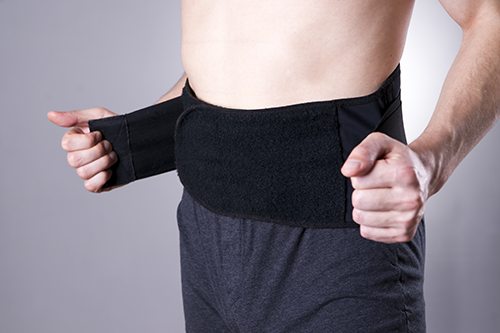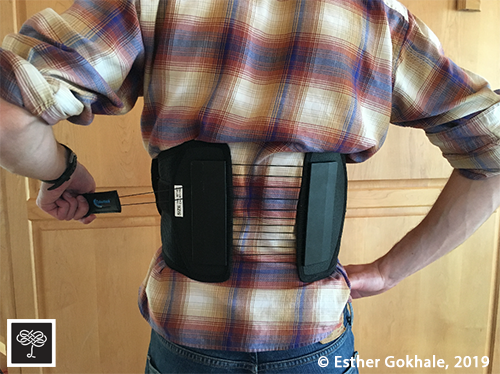When, Why, and How to Use a Back Brace
A back brace can be an invaluable support that staves away compression in the spine, and spares a vulnerable person significant damage and back pain. A back brace can also become a crutch that allows you to become weaker, less able to support your own structure, and heading into a downward spiral of dysfunction.
Ideally, your inner corset is strong enough and has enough endurance to protect your spine during all your activities. In this case, no external corset or brace is required. But there are situations in which an external device is useful or necessary.

There are many different kinds of back braces out there.
A back brace as a training device or coach
Back braces can be pretty snug, especially the ones with built-in pulley systems (see recommendations below). They can demonstrate to your body just how thin and tall it can be. It’s then easier to find the relevant muscles to replicate what the brace is doing. When you succeed in making the brace a little slack around your torso, you have engaged your inner corset and topped the brace’s cue. This is an excellent way to find and strengthen the all-important inner corset muscles.
If you’d like to read more about the inner corset, please check out Chapter 5 of my book, 8 Steps to a Pain-Free Back. A free download of Chapter 5 can be found on this page.
A back brace as a safety net
When you first discover and engage your inner corset muscles, it’s an exhausting effort. Not only are these muscles weak from disuse, but you are likely also countering tightness and shortness in the erector spinae (long back muscles) and rectus abdominis (6-pack) muscles. These superficial muscles of the torso contract inappropriately when the deep stabilizer muscles of the torso don’t do their work. Years of this kind of inappropriate engagement result in a baseline of short, tense muscles which your inner corset now needs to overcome.
It’s not uncommon for our students to begin with the challenging combination of damage in the spine, a weak inner corset, and tense erector spinae muscles. Changing this up for strength in the inner corset and length in the erector spinae muscles to protect the spine doesn’t happen overnight. Our Gokhale Method Foundations Course charts a particularly effective and efficient pathway to do just this, but in the face of pain from herniated discs, impinged nerves, and closely packed vertebrae, some immediate pain relief is welcome and encouraging. An external brace can provide support and relief while your inner corset is in training. By switching back and forth between using your inner and outer support systems, you get the best of two therapies: strengthening your muscles and protecting your spinal tissues. It also makes your journey more bearable and pleasant.
Which brace is best?
In my experience, a belt with a single Velcro strip is difficult to get strong support from. It takes a belt with two auxiliary straps in addition to the main attachment strip (shown below) to get a good fit and strong support.

It takes a belt with two auxiliary straps in addition to the main attachment strip to get a good fit and strong support. Shutterstock.
The best support I have experienced, though, comes from the belts with a pulley system built into them. Cybertech has a patent on this technology and has manufactured a vast array of braces that incorporate the pulley system. The one that students have found most helpful has medium width to go around the waist. Here is a link to it: https://amzn.to/2JfWDBq.

So far I’ve found that braces with a pulley system provide the best support.
Consider the extent of damage in your spine (how many discs are compromised?) when choosing a particular belt.
To repeat, do not use the brace in place of using your muscles. Use it as a coach to train your muscles in what they need to do. And use it as a safety net for when your muscles do not have the strength or endurance to keep you from impinging nerves or discs and experiencing pain.
Do you have experience with back belts and braces? What has been your experience?

If using a back brace
If using a back brace (temporarily), I believe it is wise to wear it lower than the picture shown, therefore reinforcing the use of "hip hinging" for body mecanics training. Wearing it just above the hip crease accomplishes that, along with education. Otherwise, as usual, I like what you are doing Esther, and have recommended your approach to many,.
Yes, training to hip-hinge
Yes, training to hip-hinge well would indeed be a good way of using it. The way shown above helps the lumbar spine lengthen and maintain its shape at other times - also useful, in my experience.
I recently bought one of
I recently bought one of those 4 strap braces for those times I was doing work that was really bothering my back. It helped a lot, but eventually slipped up and failed to support. I am also realizing that my back pain isn't caused by my back, but my upper body slouching. I just bought a shoulder brace for posture training and put some mirrors around my house to remind me when I slouch. I can have good posture if I think about it, but if not, I automatically slouch. Doing dishes is one of my biggest enemy. Any suggestions for maintaining inner corset and good shoulder posture while doing dishes?
Maybe train yourself to do
Maybe train yourself to do dishes a few times with your upper arms tied back in place?
Or cultivate familiarity with the feel associated with doing dishes well. I like to use all sorts of muscles when doing dishes to give me a very athletic feel - rhomboids, lats, longus colli, inner corset, glutes, feet. This makes doing dishes an athletic endeavor. Moving quickly and powerfully adds to the feeling.
I like Esther’s approach
I like Esther’s approach doing dishes. I hip hinge, making sure my booty is “closing the door” behind me as I’m bending my knees with weight on my heels. I’ll hold dishes while balancing arms on kitchen countertop. I hope this stance has a visual. Hello from Tulsa.